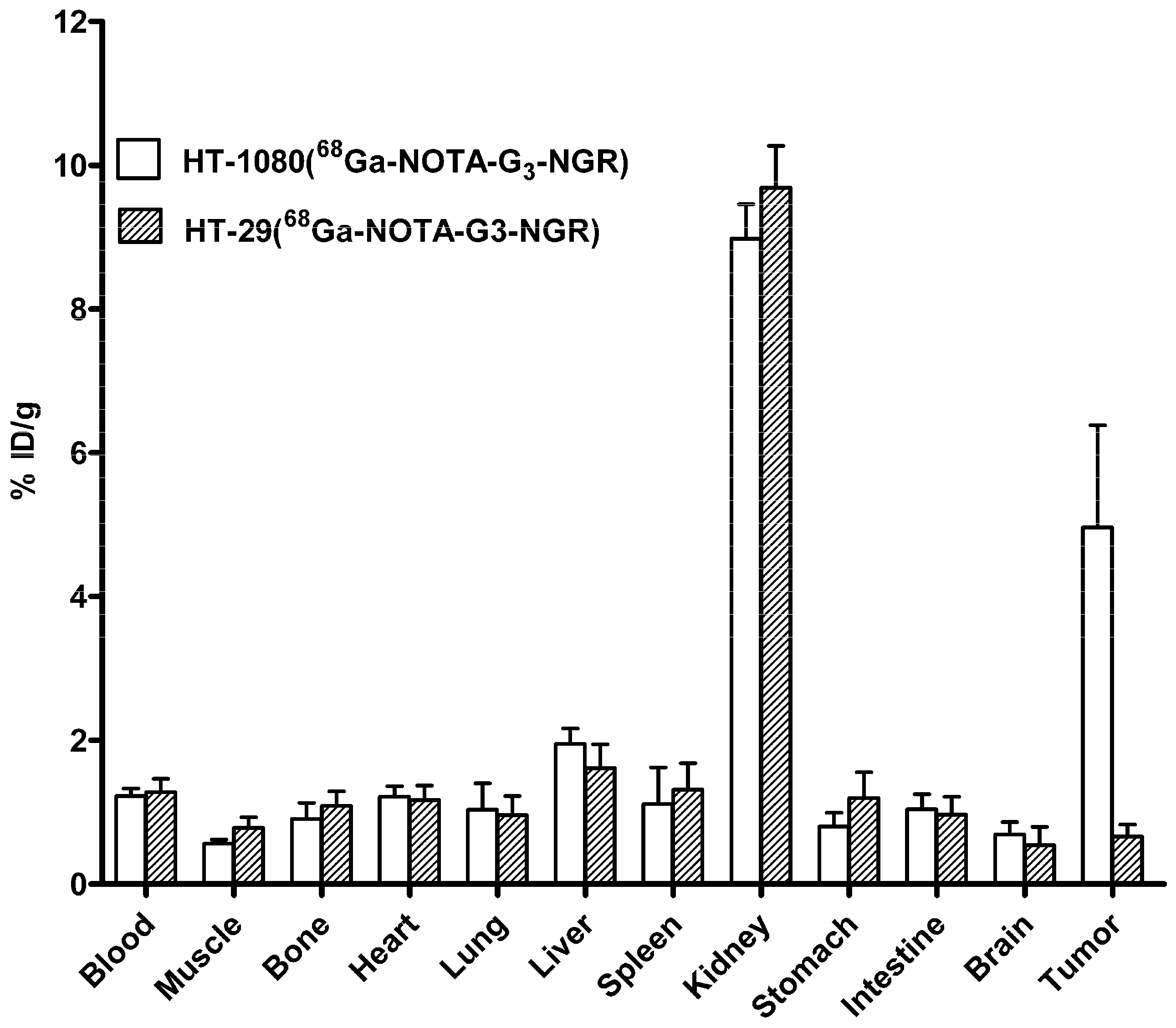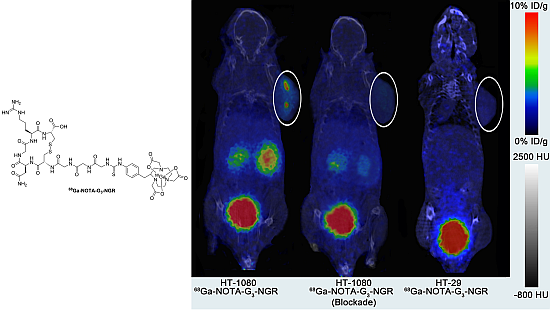68Ga-Labeled Cyclic NGR Peptide for MicroPET Imaging of CD13 Receptor Expression
Abstract
:1. Introduction
2. Results and Discussion
2.1. Chemistry and Radiochemistry

2.2. Octanol-Water Partition Coefficient
2.3. In Vitro Stability

2.4. Cell-Based Binding Assay
2.5. Cell Uptake and Efflux
2.6. MicroPET Imaging



2.7. Biodistribution Studies

3. Experimental Section
3.1. General
3.2. Synthesis of NOTA-G3-NGR
3.3. 68Ga Labeling and Formulation
3.4. Octanol–Water Partition Coefficient
3.5. In Vitro Stability
3.6. Cell Culture and Animal Model
3.7. Cell Binding Assay
3.8. Cell Uptake and Efflux
3.9. MicroPET Imaging
3.10. Biodistribution Study
3.11. Statistical Analysis
4. Conclusions
Supplementary Materials
Supplementary Files
Supplementary File 1Acknowledgments
Author Contributions
Conflicts of Interest
References
- Weissleder, R.; Mahmood, U. Molecular imaging. Radiology 2001, 219, 316–333. [Google Scholar]
- Ametamey, S.H.M.; Schubiger, PA. Molecular imaging with PET. Chem. Rev. 2008, 108, 1501–1516. [Google Scholar]
- Liang, W.; Nie, Y; Wang, J.; Wu, J.; Liu, H.; Wang, Q.; Huang, L.; Guo, H.; Shu, B.; Lv, J. Three-dimensional positron emission tomography/computed tomography analysis of 13NO3- uptake and 13N distribution in growing kohlrabi. Anal. Chem. 2011, 83, 578–584. [Google Scholar]
- Chen, K.; Chen, X. Positron emission tomography imaging of cancer biology: Current status and future prospects. Semin. Oncol. 2011, 38, 70–86. [Google Scholar]
- Chen, K.; Conti, P.S. Target-specific delivery of peptide-based probes for PET imaging. Adv. Drug Deliv. Rev. 2010, 62, 1005–1022. [Google Scholar]
- Chen, K.; Chen, X. Design and development of molecular imaging probes. Curr. Top. Med. Chem. 2010, 10, 1227–1236. [Google Scholar]
- Veleva, A.N.; Nepal, D.B.; Frederick, C.B.; Schwab, J.; Lockyer, P.; Yuan, H.; Lalush, D.S.; Patterson, C. Efficient in vivo selection of a novel tumor-associated peptide from a phage display library. Molecules 2011, 16, 900–914. [Google Scholar]
- Chen, K.; Ma, W.; Li, G.; Wang, J.; Yang, W.; Yap, L.P.; Hughes, L.D.; Park, R.; Conti, P.S. Synthesis and evaluation of 64Cu-labeled monomeric and dimeric NGR peptides for microPET imaging of CD13 receptor expression. Mol. Pharm. 2013, 10, 417–427. [Google Scholar]
- Lee, S.; Xie, J.; Chen, X. Peptide-based probes for targeted molecular imaging. Biochemistry 2010, 49, 1364–1376. [Google Scholar]
- Chen, K.; Sun, X.; Niu, G.; Ma, Y.; Yap, L.P.; Hui, X.; Wu, K.; Fan, D.; Conti, P.S.; Chen, X. Evaluation of 64Cu labeled GX1: A phage display peptide probe for PET imaging of tumor vasculature. Mol. Imaging Biol. 2012, 14, 96–105. [Google Scholar]
- Wu, A.M. Engineered antibodies for molecular imaging of cancer. Methods 2013, 65, 139–147. [Google Scholar]
- Paudyal, B.; Zhang, K.; Chen, C.P.; Wampole, M.E.; Mehta, N.; Mitchell, E.P.; Gray, B.D.; Mattis, J.A.; Pak, K.Y.; Thakur, M.L.; et al. Determining efficacy of breast cancer therapy by PET imaging of HER2 mRNA. Nucl. Med. Biol. 2013, 40, 994–999. [Google Scholar]
- Smith, A.L.; Freeman, S.M.; Stehouwer, J.S.; Inoue, K.; Voll, R.J.; Young, L.J.; Goodman, M.M. Synthesis and evaluation of C-11, F-18 and I-125 small molecule radioligands for detecting oxytocin receptors. Bioorg. Med. Chem. 2012, 20, 2721–2738. [Google Scholar]
- Marton, J.; Henriksen, G. Design and synthesis of an 18F-labeled version of phenylethyl orvinol ([18F]FE-PEO) for PET-imaging of opioid receptors. Molecules 2012, 17, 11554–11569. [Google Scholar]
- Li, Z.J.; Cho, C.H. Peptides as targeting probes against tumor vasculature for diagnosis and drug delivery. J. Transl. Med. 2012, 10, S1. [Google Scholar]
- Deutscher, S.L. Phage display in molecular imaging and diagnosis of cancer. Chem. Rev. 2010, 110, 3196–3211. [Google Scholar] [CrossRef]
- Patterson, C.; Frederick, C.B.; Yuan, H.; Dyer, L.A.; Lockyer, P.; Lalush, D.S.; Veleva, A.N. Development of a new positron emission tomography tracer for targeting tumor angiogenesis: Synthesis, small animal imaging, and radiation dosimetry. Molecules 2013, 18, 5594–5610. [Google Scholar]
- Pasqualini, R.; Koivunen, E.; Kain, R.; Lahdenranta, J.; Sakamoto, M.; Stryhn, A.; Ashmun, R.A.; Shapiro, L.H.; Arap, W.; Ruoslahti, E. Aminopeptidase n is a receptor for tumor-homing peptides and a target for inhibiting angiogenesis. Cancer Res. 2000, 60, 722–727. [Google Scholar]
- Pasqualini, R.; Koivunen, E.; Ruoslahti, E. A peptide isolated from phage display libraries is a structural and functional mimic of an RGD-binding site on integrins. J. Cell. Biol. 1995, 130, 1189–1196. [Google Scholar]
- Buehler, A.; van Zandvoort, M.A.; Stelt, B.J.; Hackeng, T.M.; Schrans-Stassen, B.H.; Bennaghmouch, A.; Hofstra, L.; Cleutjens, J.P.; Duijvestijn, A.; Smeets, M.B.; et al. CNGR: A novel homing sequence for CD13/APN targeted molecular imaging of murine cardiac angiogenesis in vivo. Arterioscler. Thromb. Vasc. Biol. 2006, 26, 2681–2687. [Google Scholar]
- Arap, W.; Pasqualini, R.; Ruoslahti, E. Cancer treatment by targeted drug delivery totumor vasculature in a mouse model. Science 1998, 279, 377–380. [Google Scholar]
- Ma, W.; Kang, F.; Wang, Z.; Yang, W.; Li, G.; Ma, X.; Li, G.; Chen, K.; Zhang, Y.; Wang, J. 99mTc-labeled monomeric and dimeric NGR peptides for SPECT imaging of CD13 receptor in tumor-bearing mice. Amino Acids 2013, 44, 1337–1345. [Google Scholar]
- Chen, K.; Wang, X.; Lin, W.; Shen, K.F.; Yap, L.P.; Hughes, L.D.; Conti, P.S. Strain-promoted catalyst-free click chemistry for rapid construction of 64Cu-labeled PET imaging probes. ACS Med. Chem. Lett. 2012, 3, 1019–1023. [Google Scholar]
- Velikyan, I. Prospective of 68Ga-radiopharmaceutical development. Theranostics 2013, 4, 47–80. [Google Scholar]
- Correia, J.D.; Paulo, A.; Raposinho, P.D.; Santos, I. Radiometallated peptides for molecular imaging and targeted therapy. Dalton Trans. 2011, 40, 6144–6167. [Google Scholar]
- Folkman, J. Role of angiogenesis in tumor growth and metastasis. Semi. Oncol. 2002, 29, 15–18. [Google Scholar]
- Sample Availability: Sample of the NOTA-G3-NGR peptide is available from the authors.
© 2014 by the authors. Licensee MDPI, Basel, Switzerland. This article is an open access article distributed under the terms and conditions of the Creative Commons Attribution license ( http://creativecommons.org/licenses/by/3.0/).
Share and Cite
Shao, Y.; Liang, W.; Kang, F.; Yang, W.; Ma, X.; Li, G.; Zong, S.; Chen, K.; Wang, J. 68Ga-Labeled Cyclic NGR Peptide for MicroPET Imaging of CD13 Receptor Expression. Molecules 2014, 19, 11600-11612. https://doi.org/10.3390/molecules190811600
Shao Y, Liang W, Kang F, Yang W, Ma X, Li G, Zong S, Chen K, Wang J. 68Ga-Labeled Cyclic NGR Peptide for MicroPET Imaging of CD13 Receptor Expression. Molecules. 2014; 19(8):11600-11612. https://doi.org/10.3390/molecules190811600
Chicago/Turabian StyleShao, Yahui, Wansheng Liang, Fei Kang, Weidong Yang, Xiaowei Ma, Guiyu Li, Shu Zong, Kai Chen, and Jing Wang. 2014. "68Ga-Labeled Cyclic NGR Peptide for MicroPET Imaging of CD13 Receptor Expression" Molecules 19, no. 8: 11600-11612. https://doi.org/10.3390/molecules190811600




